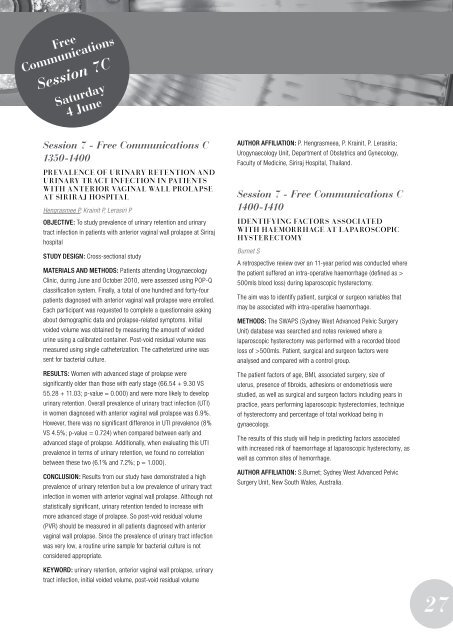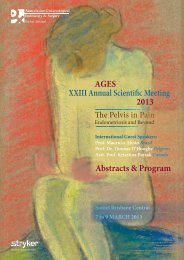to Obstetric Trauma Pelvic Floor Repair Surgical Essentials - AGES
to Obstetric Trauma Pelvic Floor Repair Surgical Essentials - AGES
to Obstetric Trauma Pelvic Floor Repair Surgical Essentials - AGES
You also want an ePaper? Increase the reach of your titles
YUMPU automatically turns print PDFs into web optimized ePapers that Google loves.
Free<br />
Communications<br />
Session 7C<br />
Saturday<br />
4 June<br />
Session 7 - Free Communications C<br />
1350-1400<br />
Prevalence of urinary retention and<br />
urinary tract infection in patients<br />
with anterior vaginal wall prolapse<br />
at Siriraj Hospital<br />
Hengrasmee P, Krainit P, Lerasiri P<br />
OBJECTIVE: To study prevalence of urinary retention and urinary<br />
tract infection in patients with anterior vaginal wall prolapse at Siriraj<br />
hospital<br />
STUDY DESIGN: Cross-sectional study<br />
MATERIALS AND METHODS: Patients attending Urogynaecology<br />
Clinic, during June and Oc<strong>to</strong>ber 2010, were assessed using POP-Q<br />
classification system. Finally, a <strong>to</strong>tal of one hundred and forty-four<br />
patients diagnosed with anterior vaginal wall prolapse were enrolled.<br />
Each participant was requested <strong>to</strong> complete a questionnaire asking<br />
about demographic data and prolapse-related symp<strong>to</strong>ms. Initial<br />
voided volume was obtained by measuring the amount of voided<br />
urine using a calibrated container. Post-void residual volume was<br />
measured using single catheterization. The catheterized urine was<br />
sent for bacterial culture.<br />
RESULTS: Women with advanced stage of prolapse were<br />
significantly older than those with early stage (66.54 + 9.30 VS<br />
55.28 + 11.03; p-value = 0.000) and were more likely <strong>to</strong> develop<br />
urinary retention. Overall prevalence of urinary tract infection (UTI)<br />
in women diagnosed with anterior vaginal wall prolapse was 6.9%.<br />
However, there was no significant difference in UTI prevalence (8%<br />
VS 4.5%; p-value = 0.724) when compared between early and<br />
advanced stage of prolapse. Additionally, when evaluating this UTI<br />
prevalence in terms of urinary retention, we found no correlation<br />
between these two (6.1% and 7.2%; p = 1.000).<br />
CONCLUSION: Results from our study have demonstrated a high<br />
prevalence of urinary retention but a low prevalence of urinary tract<br />
infection in women with anterior vaginal wall prolapse. Although not<br />
statistically significant, urinary retention tended <strong>to</strong> increase with<br />
more advanced stage of prolapse. So post-void residual volume<br />
(PVR) should be measured in all patients diagnosed with anterior<br />
vaginal wall prolapse. Since the prevalence of urinary tract infection<br />
was very low, a routine urine sample for bacterial culture is not<br />
considered appropriate.<br />
AUTHOR AFFILIATION: P. Hengrasmeea, P. Krainit, P. Lerasiria;<br />
Urogynaecology Unit, Department of <strong>Obstetric</strong>s and Gynecology,<br />
Faculty of Medicine, Siriraj Hospital, Thailand.<br />
Session 7 - Free Communications C<br />
1400-1410<br />
Identifying fac<strong>to</strong>rs associated<br />
with haemorrhage at laparoscopic<br />
hysterec<strong>to</strong>my<br />
Burnet S<br />
A retrospective review over an 11-year period was conducted where<br />
the patient suffered an intra-operative haemorrhage (defined as ><br />
500mls blood loss) during laparoscopic hysterec<strong>to</strong>my.<br />
The aim was <strong>to</strong> identify patient, surgical or surgeon variables that<br />
may be associated with intra-operative haemorrhage.<br />
METHODS: The SWAPS (Sydney West Advanced <strong>Pelvic</strong> Surgery<br />
Unit) database was searched and notes reviewed where a<br />
laparoscopic hysterec<strong>to</strong>my was performed with a recorded blood<br />
loss of >500mls. Patient, surgical and surgeon fac<strong>to</strong>rs were<br />
analysed and compared with a control group.<br />
The patient fac<strong>to</strong>rs of age, BMI, associated surgery, size of<br />
uterus, presence of fibroids, adhesions or endometriosis were<br />
studied, as well as surgical and surgeon fac<strong>to</strong>rs including years in<br />
practice, years performing laparoscopic hysterec<strong>to</strong>mies, technique<br />
of hysterec<strong>to</strong>my and percentage of <strong>to</strong>tal workload being in<br />
gynaecology.<br />
The results of this study will help in predicting fac<strong>to</strong>rs associated<br />
with increased risk of haemorrhage at laparoscopic hysterec<strong>to</strong>my, as<br />
well as common sites of hemorrhage.<br />
AUTHOR AFFILIATION: S.Burnet; Sydney West Advanced <strong>Pelvic</strong><br />
Surgery Unit, New South Wales, Australia.<br />
KEYWORD: urinary retention, anterior vaginal wall prolapse, urinary<br />
tract infection, initial voided volume, post-void residual volume<br />
27

















